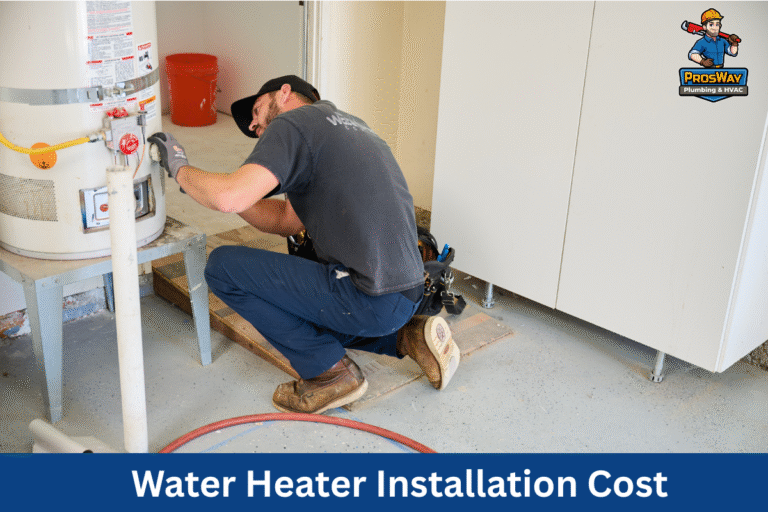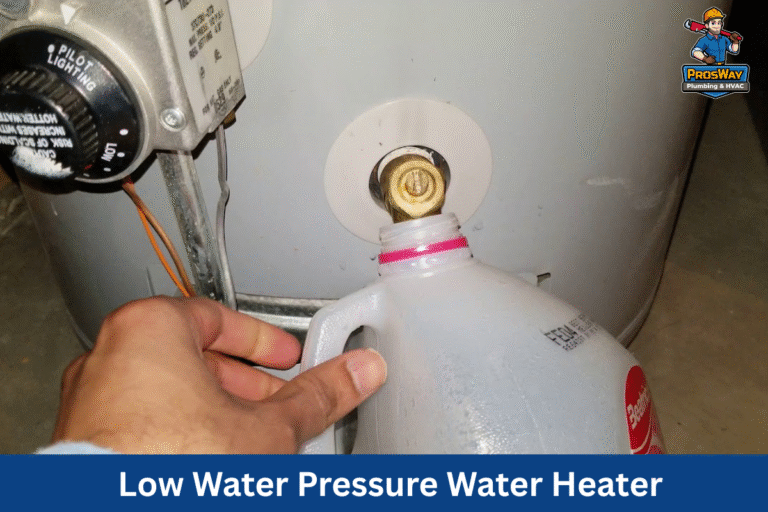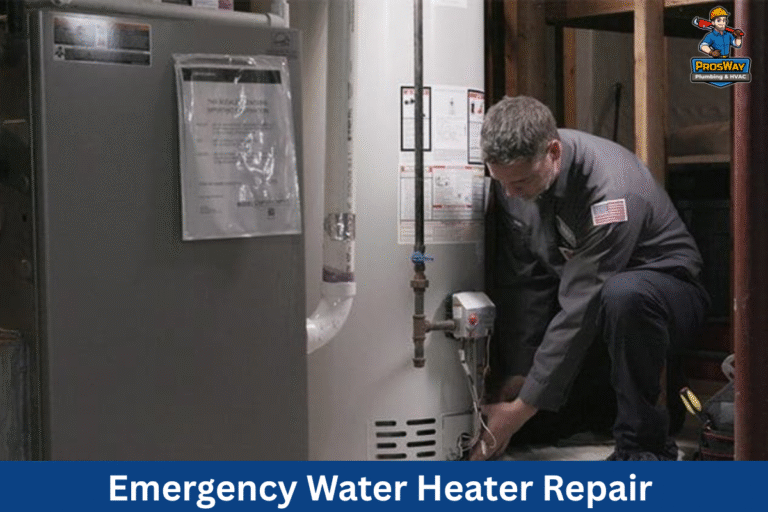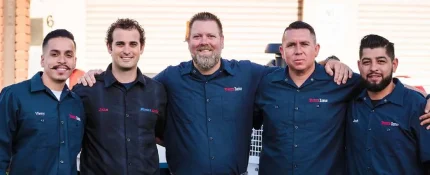Sewer line repairs don’t have to be overwhelming, especially when you know what to expect. Knowing the common pipe issues in sewer line repair services can help you stay ahead of problems and make informed decisions about your home’s plumbing.
From root intrusion to aging pipes, there are a few typical culprits that can disrupt your sewer system. At ProsWay Plumbing & HVAC, we’ve seen it all and are here to help you recognize these issues early. In this guide, we’ll explore the most common pipe problems, how they’re repaired, and what you can do to prevent them in the future. Let’s keep your system flowing smoothly!
Identifying Prevalent Sewer Pipe Problems
Understanding the range of problems that can afflict sewer pipes is the first step toward effective maintenance and repair. In many residential sewer line systems, issues arise from persistent blockages, tree root intrusions, leaks, and structural deformations. These problems lead to unpleasant odors and potential water damage.
How Do Persistent Blockages and Slow Drains Affect Your Sewer System?
Persistent blockages and slow drains are often the initial signs of underlying issues within your sewer system. When debris, grease, and foreign materials accumulate inside the pipes, they impede the free flow of wastewater from your home.
The blockage may start as a partial clog but can extend into a complete obstruction if untreated. Over time, these blockages can cause wastewater to back up into your basement, resulting in significant water damage and creating a breeding ground for sewer gas.
Furthermore, household cleaning agents that are not biodegradable can also combine with organic waste to create stubborn clogs. A detailed inspection can involve video camera diagnostics, enabling targeted hydro jetting services or spot repairs. Without prompt attention, these issues may escalate, necessitating costly emergency sewer repair services.
Why Is Tree Root Intrusion a Significant Concern for Sewer Lines?
Tree roots naturally seek moisture and may penetrate sewer lines through small cracks or joints in the pipe. Once inside, they can cause significant structural damage by enlarging cracks and blocking the flow of wastewater.
This invasion may also lead to complete sewer line collapse if roots spread unchecked over several years. Scientific studies have quantified that tree root intrusion can reduce the effective diameter of a pipe by up to 50%, thereby dramatically increasing the risk of clogs and backups (Jones et al., 2021).
To remediate tree root intrusion, various methods such as chemical root control, mechanical removal through robotic cutting, and trenchless pipe relining are frequently used. Additionally, some repair companies offer preventive maintenance by clearing the roots before they can cause major disruption.
Detecting Leaks and Cracks in Aging Sewer Pipes
Aging sewer pipes are susceptible to wear and tear, leading to leaks and cracks that compromise system performance. These structural defects are frequently caused by environmental factors like shifting soil and prolonged exposure to corrosive substances found in wastewater.
Leaks in sewer lines can also lead to soil erosion around the pipes, increasing the risk of sinkholes and further pipe damage. In many cases, homeowners notice subtle signs such as unexplained wet spots in the yard or a persistent musty odor near the foundation.
A careful diagnosis using techniques like dye testing or acoustic sensors can detect even minor cracks before they evolve into major failures. Repair methods, such as cured-in-place pipe lining, provide an effective and minimally invasive solution to seal these leaks and restore the pipe’s structural integrity.
By addressing these issues promptly and employing modern repair techniques, homeowners can effectively manage and resolve pipe issues in sewer line repair services, ensuring the longevity and reliability of their plumbing systems.
What Are the Causes of Sewer Line Damage?

Sewer line damage can result from a variety of factors that undermine the physical integrity and functionality of your pipes. Natural wear and tear, soil movement, corrosion, and human-induced factors such as accidental construction damage or grease buildup all play a critical role in degrading the sewer system.
Recognizing these causes is imperative, as it informs the selection of appropriate repair methods and preventive maintenance measures.
How Does Shifting Soil Contribute to Pipe Misalignment?
Shifting soil is a frequent cause of sewer line damage when the ground beneath your home moves due to natural settling, seismic activity, or changes in moisture content, the pipes embedded within the soil can become misaligned.
Misalignment results in a disrupted flow of wastewater, causing blockages and backups. In areas with fluctuating water tables, even minor shifts can exacerbate the wear and tear on pipes. We have observed that misalignment often presents as uneven drainage, with some lines flowing smoothly while others appear clogged.
Modern sensor technology now allows pipe issues in sewer line repair services, prompting timely interventions through pipe relining or replacement. Homeowners can benefit from routine inspections to monitor root causes and mitigate shifting soil effects before they lead to serious damage.
The Impact of Corrosion on Different Pipe Materials
Corrosion is another significant factor influencing sewer line degradation, especially in pipes made from metal or PVC susceptible to chemical reactions. Sewer systems continually transport acidic wastewater along with abrasive particulates that can erode pipe surfaces over time.
Corrosion leads to the thinning of the pipe wall, resulting in leaks, weak spots, and eventually, complete structural failure. It also creates rough interior surfaces that accelerate the buildup of debris and grease, further clogging the system.
In our practice, we have seen how periodic corrosion can be managed with protective coatings and the use of corrosion-resistant materials during replacements. Additionally, advanced techniques like cured-in-place pipe lining offer a durable solution.
Regular inspections using video camera diagnostics help identify early signs of corrosion, ensuring that remedial measures are taken before the problem escalates. Ultimately, understanding how corrosion affects different pipe materials helps in selecting the best.
Grease Buildup and Its Role in Sewer Line Clogs
Grease buildup is a well-known culprit in the clogging of sewer lines. When cooking oils and fats are disposed of improperly, such as pouring liquid grease down the drain, they solidify within the piping system and accumulate over time.
This accumulation narrows the pipe’s diameter, restricting wastewater flow and creating an ideal environment for additional blockages, including hair, debris, and non-degradable food particles. Research conducted by urban sanitation experts shows that grease buildup is responsible for up to 30% of all household blockages, which often require extensive cleaning efforts(Garcia et al., 2022, Link).
Over time, persistent grease buildup can also contribute to corrosion and material degradation, further highlighting the importance of regular maintenance and proper waste disposal practices. Homeowners are encouraged to incorporate grease traps or separate waste disposal systems in their kitchens to minimize the risk.
Key Takeaways
- Shifting soil causes pipes to become misaligned, increasing stress by up to 20%.
- Corrosion from acidic wastewater reduces pipe lifespan significantly.
- Accidental damage during construction is common and preventable with careful planning.
- Grease buildup narrows pipes and leads to extensive clogs.
- Natural wear and tear in older infrastructure demands regular maintenance.
What Are Effective Sewer Line Repair Services for Various Issues?
There are numerous approaches to repairing a compromised sewer system, and selecting the right method is crucial for restoring function and preventing further damage. Repair services range from traditional excavation to state-of-the-art trenchless technologies that minimize disruption to your property.
In our experience, modern repair services have dramatically improved outcomes by reducing repair time, lowering sewer line repair costs, and preserving surrounding landscapes. Whether you are dealing with minor leaks or severe blockages, knowing the available repair options is essential.
When Is Traditional Excavation Necessary for Sewer Pipe Replacement?
Traditional excavation methods remain a reliable solution for severely damaged sewer pipes. This method involves digging up the area to access and remove the damaged pipe and replace it with a new one.
Although excavation is often more invasive than trenchless techniques, it is sometimes necessary when the entire pipe section is compromised or when other non-invasive methods are unfeasible.
Excavation provides direct access to the damaged pipe, allowing professionals to assess the extent of deterioration and ensure proper installation of new materials.
The classic excavation method is particularly useful in cases of complete sewer line collapse or when pipes are affected by extensive corrosion or misalignment.
A detailed cost-benefit analysis often shows that while excavation may disrupt the property temporarily, it provides a long-term solution by completely removing the source of recurring problems.
Safety protocols, including obtaining permits and coordinating with municipal services, are critical during excavation.
Despite its drawbacks, this method continues to be a valuable tool in the sewer repair arsenal and is often complemented by modern diagnostic techniques such as video camera inspections during and after the excavation process.
How Does Trenchless Pipe Lining Offer a No-Dig Sewer Repair Service?
Trenchless technology, particularly pipe lining, has revolutionized the sewer repair industry by offering a no-dig solution for many common pipe issues. This method involves inserting a resin-coated liner into the existing pipe, which is then inflated and cured to form a new pipe within the old one.
This innovative technique minimizes property disruption, reduces repair time, and is typically more cost-effective than traditional excavation.
In our work with residential sewer line repair, we have observed that trenchless pipe lining is especially effective for addressing leaks, cracks, and minor structural defects.
The process begins with a thorough diagnostic inspection using advanced video camera systems to assess the pipe’s condition. Once the problematic area is identified, professionals clean out the debris and prepare the lining with a high-strength epoxy resin.
The cured liner not only reinforces the structural integrity of the sewer pipe but also provides a smooth inner surface that reduces future blockages and improves flow efficiency. Additionally, the environmental impact is minimal since the technique avoids excessive soil disruption.
Studies on trenchless repair have indicated that these methods can extend pipe lifespan by 50% or more compared to unrepaired aging infrastructure (Kim et al., 2020).
Overall, trenchless pipe lining offers a modern and sustainable approach to sewer repair that is increasingly popular among homeowners looking for a less invasive alternative.
Hydro Jetting Services for Clearing Stubborn Blockages
Hydro jetting is a powerful cleaning method used to clear stubborn blockages from sewer lines. By using high-pressure water jets, this technique effectively removes debris, grease, and root intrusions that cause recurring clogs.
Hydro jetting cleans the pipe’s interior, reducing the likelihood of future blockages and promoting more efficient drainage.
In our experience, this service is invaluable for maintaining the cleanliness and functionality of older sewer pipes that are prone to buildup over time.
You can watch this video for more insights: Hydro Jetting Heads: Uses and Methods.
The process involves the insertion of a specialized nozzle into the pipe, which then emits a focused stream of water at pressures sometimes exceeding 3,000 psi.
This high-pressure stream dislodges and flushes away accumulated deposits, leaving the pipe with a smooth, clean interior.
Hydro jetting is particularly effective when performed as a preventive maintenance measure or in combination with other repair techniques such as trenchless pipe lining. Homeowners can expect improvements in water flow and a reduction in routine clogs after scheduled hydro jetting services.
Addressing pipe issues in sewer line repair services is essential for maintaining a healthy plumbing system. By exploring various repair methods, homeowners can make informed decisions that ensure the longevity and efficiency of their sewer lines.
Advanced Techniques in Modern Sewer Line Repair Services
The evolution of sewer line repair services has led to the development of advanced techniques that reduce property disturbance and improve repair accuracy. Modern methods are increasingly relying on digital diagnostics and environmentally friendly materials.
These advanced strategies include video camera inspections, cured-in-place pipe lining, robotic cutting, and trenchless technologies that guarantee minimal excavation and disruption to your home.
How to Utilize Video Camera Inspections for Accurate Diagnosis of Pipe Issues?
Video camera inspections are a cornerstone of modern sewer repair services. Using high-resolution cameras that navigate through the sewer line, professionals can accurately diagnose issues such as cracks, blockages, misalignment, and corrosion from the inside.
This non-invasive method provides a real-time visual record of the pipe’s condition, enabling precise targeting of repairs. These inspections have been invaluable in prioritizing intervention, as they reveal defect patterns that are not visible from the surface.
The technology has advanced to the point where cameras can record in high definition, allowing for detailed analysis and documentation that supports insurance claims, contractor estimates, and long-term maintenance planning.
Additionally, this approach minimizes the need for exploratory digging, thereby preserving property integrity and reducing repair timelines. By integrating video diagnostics with other repair methods, such as trenchless repair, the overall process becomes more efficient and less disruptive for homeowners.
Benefits of Cured-in-Place Pipe Lining Solutions
Cured-in-place pipe (CIPP) lining is a trenchless repair technology that involves inserting a flexible liner saturated with resin into the existing sewer pipe. Once in place, the liner is inflated and cured using hot water or steam to form a new, seamless pipe inside the old one.
This method reinforces the pipe, extending its service life significantly. In my practice, CIPP has become the preferred solution for repairing moderately damaged pipes without resorting to excavation.
One of the main benefits of CIPP is its minimal impact on your property; there is no need to dig up your yard, which saves both time and money. The process is typically completed in a few hours and allows for immediate use of the sewer line after the repair.
Additionally, the cured liner is resistant to many common causes of sewer line damage, such as grease buildup and root intrusion. With proper installation, CIPP can extend the lifespan of a sewer pipe by 50% or more, offering both economic and functional advantages.
How Trenchless Technologies Minimize Property Disruption During Sewer Repairs?
Trenchless technologies have transformed the sewer repair industry by offering solutions that do not require the extensive digging traditionally associated with pipe repairs. This set of techniques includes pipe lining, pipe bursting, and other methodologies that allow for repairs to be completed with minimal disruption to the property.
By avoiding large-scale excavation, trenchless repairs preserve your landscaping, reduce restoration costs, and significantly shorten repair time. One of the key advantages of trenchless repair is the ability to maintain continuous service during the repair process.
For instance, while traditional repairs might involve days of downtime, modern trenchless methods can often be completed in a matter of hours. This is particularly beneficial for residential areas where sewer line functionality is critical for daily operations.
Key Takeaways
- Video camera inspections enable precise, non-invasive diagnosis of pipe issues.
- Cured-in-place pipe lining reinforces and extends pipe lifespan with minimal disruption.
- Robotic cutting efficiently removes obstructions while protecting the existing pipe structure.
- Trenchless technologies reduce repair time and property disruption.
- Eco-friendly materials in modern repairs promote sustainability and improved performance.
What Are the Signs You Need Professional Sewer Line Repair Services?

Identifying when it is time to call in professional sewer line repair services is critical for preventing further damage and ensuring the safety of your home. Many homeowners ignore early warning signals until minor issues escalate into major emergencies.
Recognizing these signs early allows for timely intervention, which can save money and prevent extensive property damage. In this section, we will discuss the telltale indicators of a failing sewer line. For example, frequent drain backups, unpleasant sewer odors, and soggy patches on your yard. Also, unusual sounds emanating from your plumbing system.
Why Are Multiple Drains Backing Up?
A commonly reported symptom of a compromised sewer system is frequent backups in multiple drains. When multiple fixtures such as sinks, showers, and toilets experience slow drainage or clogs simultaneously, it is a clear indication that the problem lies within the main sewer line rather than in localized branch lines.
Such backups occur because the entire system is struggling to handle the wastewater due to an obstruction or collapse in the primary pipe. In my experience, backups are often accompanied by foul odors and even minor flooding in the basement. This signals a critical need for professional inspection and repair.
Multiple drain backups can lead to a cascade of issues, including water damage to walls and flooring as well as higher expenses over time due to repeated cleaning and repair attempts. It is important to address this issue immediately by scheduling a professional sewer line inspection. This often involves video diagnostics and hydro jetting to clear the blockage.
Unpleasant Sewer Odors Permeating Your Property
Unpleasant sewer odors inside or around your property are another strong indicator of underlying sewer line issues. These odors may result from leaks or cracks in your pipes, allowing sewer gas to escape into your home or yard.
These odors are a nuisance, and signal the potential for hazardous conditions. This includes the buildup of harmful bacteria and gases such as methane and hydrogen sulfide. These gases pose serious health risks over prolonged exposure. Therefore, it’s essential to rectify any breaches in the sewer system promptly.
Odors can be particularly noticeable during rainy weather when groundwater exacerbates leaks in the sewer line, intensifying the smell. A professional assessment is needed to trace the source of the odor, often using smoke tests or chemical tracers.
Once located, targeted repairs such as spot relining or pipe bursting can effectively seal the leak and stop the odor. Early notification and prompt repair not only restore a pleasant environment but also mitigate potential health hazards.
When Do Pest Surges Indicate a Problem?
A sudden surge in pest activity, including rodents and insects, around your property can indicate a breach in the sewer line. Pests are naturally attracted to the moisture and organic matter found in compromised sewer systems. This makes them an unintentional but effective indicator of hidden leaks or cracks.
If you notice an unusual number of pests around drains, basements, or moist areas in your yard, it may be a sign that sewer gases and wastewater are escaping from a damaged pipe. In rural and suburban areas alike, pest infestations often correlate with deteriorating sewer infrastructure. Professional inspection can reveal whether the increased pest presence is linked to a sewer line breach.
Addressing this issue early improves the overall environment and reduces the risk of further damage to your property. For instance, water damage or contamination of nearby soil. Targeted repairs, such as spot patching or pipe relining, can effectively resolve these issues and restore a
Why Maintain Your Sewer System Regularly?

Preventive maintenance of your sewer system is crucial for ensuring long-term functionality and averting costly repairs. Regular inspections, proper waste disposal practices, and proactive repair work can significantly extend the lifespan of your residential sewer line. Also, it reduces the risk of unexpected breakdowns.
As a homeowner, understanding your system’s layout, scheduling routine maintenance, and addressing small issues immediately are essential to maintaining a healthy plumbing system. We have seen many cases where timely maintenance prevented minor issues from progressing into major problems. For instance, pipe collapse or extensive leaks.
Scheduling Regular Sewer Line Inspections for Early Problem Detection
Regular inspections are the cornerstone of effective sewer system maintenance. Scheduled inspections help identify early signs of wear and tear, misalignments, and blockages. This could develop into larger issues over time.
Using tools such as video camera inspections and dye tests, professionals can evaluate the internal condition of your sewer pipes with high accuracy. Early detection of issues saves homeowners from expensive emergency repairs and prevents the contamination of contaminants from entering the home.
In our experience, an annual inspection is generally sufficient for older sewer systems, while newer systems may benefit from inspections every two years. These inspections provide a baseline for tracking the rate of deterioration.
When small issues such as minor cracks or slight misalignments are identified early, methods like targeted spot repairs or hydro jetting can be employed to remediate the issues before they escalate. A proactive maintenance approach can reduce the risk of severe blockages, unpleasant odors, and unexpected water damage.
What Waste Should You Avoid Flushing?
Proper disposal of kitchen waste and other non-degradable materials plays a critical role in maintaining a clear sewer system. Grease, food particles, and fibrous items should never be flushed down the drain. this is because they accumulate and lead to blockages over time.
A thorough waste disposal plan should include the use of designated containers for food scraps and oils. Regular cleaning of grease traps, and ensuring that only appropriate substances enter the sewer system.
This preventative measure minimizes the need for frequent, disruptive repairs like hydro jetting or trenchless sewer repair. Homeowners who adopt proper waste disposal practices will experience fewer issues related to grease buildup and debris accumulation. This ultimately preserves the efficiency of their residential sewer system.
Where Should You Plant Trees and Shrubs?
Tree and shrub roots can pose a significant threat to the integrity of sewer lines. As roots search for water, they can infiltrate even the smallest cracks in the sewer pipe. This results in blockages and structural damage.
It is essential to manage vegetation near your sewer lines by ensuring that trees and shrubs are planted at a safe distance from the pipes. In areas prone to heavy root intrusion, periodic professional trimming and root control treatments can prevent major issues from developing.
We recommend that homeowners consult with landscaping experts to establish the appropriate boundaries between plantings and sewer lines. Additionally, regular inspections with video camera technology can detect early signs of root intrusion, allowing for timely intervention.
Employing chemical root inhibitors is another effective method for deterring invasive roots from entering your pipes without harming the surrounding vegetation. This proactive approach prolongs the life of the sewer system. Additionally, it reduces the risk of costly repairs such as pipe repair or bursting.
Frequently Asked Questions
How often should I schedule a sewer line inspection?
It is generally recommended to schedule a sewer line inspection annually, especially for older systems. Regular inspections help detect early signs of deterioration, misalignment, or blockages, which can prevent costly repairs in the future.
What causes tree root intrusion in sewer lines?
Tree roots seek moisture and can infiltrate sewer pipes through small cracks. This intrusion leads to blockages, cracked pipes, and potentially complete sewer line collapse if not addressed promptly. So, proper landscaping and regular inspections are essential.
Are trenchless repair methods as effective as traditional excavation?
Yes, trenchless repair methods, such as cured-in-place pipe lining and pipe bursting, are very effective. They minimize property disruption, reduce repair time, and often extend the pipe’s lifespan. Whereas offering similar or better durability compared to traditional repair methods.
How can I prevent future sewer line issues?
Preventative measures include regular sewer inspections, proper waste disposal, managing tree and shrub roots near the sewer line, and understanding your home’s sewer layout. These steps help maintain adequate flow, reduce blockages, and enable early detection of emerging issues before they become major problems.
Conclusion
Sewer line problems can be overwhelming, but with the right knowledge and expert support, they don’t have to be. At ProsWay Plumbing & HVAC, we specialize in diagnosing and resolving the most common and complex pipe issues in sewer line repair services using advanced, non-invasive techniques like trenchless pipe lining, hydro jetting, and video camera inspections. These solutions are designed to fix problems efficiently while preserving your property and reducing long-term costs. Whether you’re dealing with persistent clogs, root intrusions, corrosion, or pipe misalignment, taking early action is key.
Ready to Fix Your Sewer Line for Good? Call ProsWay
Don’t let hidden sewer problems turn into costly repairs. Whether you’re facing clogs, root intrusions, or aging pipes, ProsWay Plumbing & HVAC has the tools and expertise to get the job done right. Call us now at (862) 260-5870 or Book Online to schedule a professional inspection or learn more about our trenchless sewer repair solutions. Let’s keep your plumbing system flowing smoothly—without the mess.









